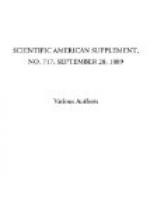“It is now thirty years since the first dwelling house in Salem was lighted by electricity. That little obscure dwelling, 11 Pearl Street, formerly owned by ‘Pa’ Webb, had the honor to be illuminated by the effulgent electric beam during every evening of July, 1859, as some of your honored residents, perhaps, well remember. Mr. George D. Phippen can doubtless testify to one or more evenings; Mr. Wm. H. Mendell, of Boston, can also add his testimony; dozens of others could also do the same, had not some of them already passed to the ‘great beyond,’ among whom I well recollect the interest taken by the late and honored Henry L. Williams, Mr. J. G. Felt, and I do not know how many others. I well remember reading some of the very finest print standing with my back to the front wall and reading by the light of a 32 candle power lamp on the northernmost end of the mantel piece in the parlor; very possibly the hole in which the lamp was fastened remains to this day. In a little closet in the rear sleeping room was a switch which could be turned in one direction and give a beautiful glow light, while if turned in the other direction, it instantly gave as beautiful a dark. My then 12 year old daughter used to surprise and please her visitors by suddenly turning on and off the ‘glim.’ It is not well to despise the day of small things, for although the dynamo had not at that date put in an appearance, and though I used thirty-six Smee cells of six gallons capacity each, yet I demonstrated then and there that the incandescent electric light was a possibility, and although I innocently remarked to the late Samuel W. Bates, of Boston, who with his partner, Mr. Chauncey Smith, furnished so generously in the interest of science, not wholly without hope of return, the funds for the experiment, that it ‘did not take much zinc,’ and though Mr. Bates as naively replied, ‘I notice that it takes some silver, though,’ still it was then and there heralded as the coming grand illuminant for the dwelling. I am thankful to have lived to see my predictions partly fulfilled.
“During the early fifties I published a statement something like this: ’One pound of coal will furnish gas enough to maintain a candle light for fifteen hours. One pound of gas (the product of five pounds of coal) will, in a good fishtail gas burner, furnish one candle light for seventy-five hours. One pound of coal burned in a good furnace, under a good boiler, driving a good steam engine, turning a good magneto-electric machine, will give a candle light for one thousand hours. But if all the energy locked up in one pound of pure carbon could be wholly converted into light, it would maintain one candle light for more than one and a half years.’
“So, gentlemen, nil desperandum; there is still room for improvement. Let your motto be ‘Excelsior.’ Possibly you may have already extracted from one-fifteenth to one-twelfth of the energy stored in the pound of carbon, but hardly more. Go on, go on, and bring it so cheap as to reach the humblest dwelling when you shall celebrate the centennial of the opening of your new station.




